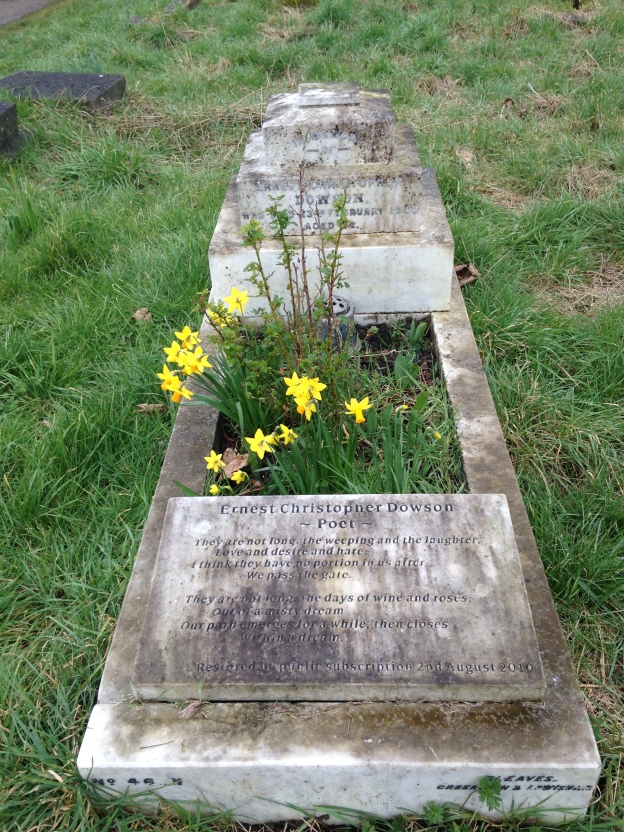Running Past has covered several of the poets who have passed through Lewisham at various stages in their lives – Robert Browning, who lived in New Cross for a while in the 1840s, Thomas Dermody who died in a hovel on Perry Vale and was buried at St Mary’s Lewisham along with James Elroy Flecker, who was born in Gilmore Road. Another who passed through was the ‘decadent’ poet, Ernest Dowson, whose final resting place is in Ladywell and Brockley Cemetery.
Dowson was born on 2 August 1867 at 11 The Grove (now Belmont Grove) off Belmont Hill. The house is no longer there; it was probably demolished during the early 1930s and replaced with a large block of council flats with more than a nod towards Art Deco, the appropriately named Dowson Court. He is remembered there though with one of Lewisham’s maroon plaques; as is next door neighbour Edward Owen Greening, also has a maroon plaque. Both have matching overflows next to them.
Dowson was the elder son of Annie and Alfred. They may not have stayed in Lee that long after Ernest’s birth – they were recorded as living in Weston-Super-Mare in the 1871 census and in Barnstaple in 1881, although it seems that the family travelled a lot around Europe in an attempt to find relief for his father’s tuberculosis. Dowson went to Oxford in 1886 but left before the end of his second year, without a degree. He returned to London to help run the family owned dock, seemingly without much enthusiasm becoming involved with London literary society – knowing the like of Wilde and Yates and joining The Rhymers Club contributing poems to their annual collections in 1892 and 1894.
He became infatuated with Adelaide “Missie” Foltinowicz when she served him, aged just 11 in a restaurant in 1889. He was to later unsuccessfully propose to her, and was left devastated when she eventually married someone else. He wrote extensively about her, often with overtones of paedophilia; although it has been suggested that Dowson (pictured below – source) was looking for eternal love rather than sexual gratification. It was certainly considered ‘eccentric rather than deviant’ at the time.
His father died from an overdose of chloral hydrate in August 1894, probably a suicide as he was in the advanced stages of tuberculosis; his mother took her life early the following year. Their deaths, along with the rejection by “Missie” seems to have caused Dowson to embark on a downward spiral of self-indulgence and drink, he became addicted to absinthe – a strong spirit, later banned in many countries, ostensibly due to purported hallucinogenic properties.
The publisher Leonard Smithers gave him an allowance to move to France and write translations in an unsuccessful attempt to try to shake him out of his dissolute lifestyle. Dowson returned to London and stayed with the Foltinowicz family during 1897.
He was found drunk and penniless in a central London wine bar by the novelist and biographer, Robert Sherard and he was to spend his final weeks in ‘a cottage in Catford, where Sherard was living.’ Bucolic idyl it most certainly wasn’t – Catford was mid-way through its transition to suburbia through the likes of Cameron Corbett and James Watt. The ‘cottage’ was in reality a two bedroom terraced house at 26 Sandhurst Gardens (now 159 Sangley Road). Sherard noted
Our fashionable residence is in a row of cottages about 200 yards up the lane (from the Plough and Harrow). The lane is a mud swamp.
As was common in poor households, the house was shared with a building worker and his family. While Sherard had left by the time the census enumerators called in 1901 – 26 Sandhurst Gardens was then home to two households with 9 people.
Dowson was to die at Sandhurst Gardens on 23 February 1900, he was buried four days later on the Ladywell side of what is now Brockley and Ladywell Cemetery in an area reserved for Catholics. 
Oscar Wilde wrote on hearing of Dowson’s death
Poor wounded wonderful fellow that he was, a tragic re-production of all tragic poetry, like a symbol or a scene. I hope bay leaves will be laid on his tomb, and rue, and myrtle too, for he knew what love is.
The grave was restored through public subscription in 2010 with a ceremony on what would have been the poet’s 143rd birthday.
While there is no plaque on his place of death at Sangley Road, in addition to the plaque in Lee and the grave, he is ‘commemorated’ by an information panel in Wetherspoons in Catford, given his downward alcoholic spiral, this is perhaps an appropriate accolade.
Whilst drunk he apparently said the immortal words ‘absinthe makes the tart grow fonder’, but a post about a poet needs some poetry – a good, accessible starting point is his poem – Autumnal – which starts
Pale amber sunlight falls across
The reddening October trees,
That hardly sway before a breeze
As soft as summer: summer’s loss
Seems little, dear! On days like these.
Let misty autumn be our part!
The twilight of the year is sweet:
Where shadow and the darkness meet
Our love, a twilight of the heart
Eludes a little time’s deceit.
However, Dowson is probably best known for ‘Vitae Summa Brevis’ (appropriately translated as ‘The shortness of life forbids us long hopes), which now appears on his grave
They are not long, the weeping and the laughter,
Love and desire and hate:
I think they have no portion in us after
We pass the gate.
They are not long, the days of wine and roses:
Out of a misty dream
Our path emerges for a while, then closes
Within a dream.




